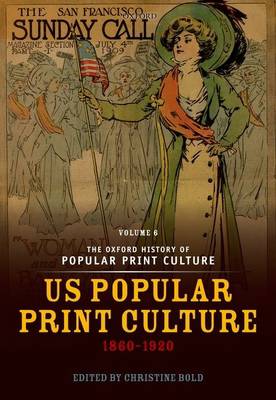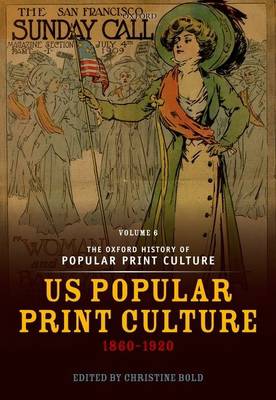
- Afhalen na 1 uur in een winkel met voorraad
- Gratis thuislevering in België vanaf € 30
- Ruim aanbod met 7 miljoen producten
- Afhalen na 1 uur in een winkel met voorraad
- Gratis thuislevering in België vanaf € 30
- Ruim aanbod met 7 miljoen producten
Zoeken
The Oxford History of Popular Print Culture
Volume Six: Us Popular Print Culture 1860-1920
Christine Bold
€ 297,95
+ 595 punten
Omschrijving
What did most people read? Where did they get it? Where did it come from? What were its uses in its readers' lives? How was it produced and distributed? What were its relations to the wider world of print culture? How did it develop over time? These questions are central toThe Oxford History of Popular Print Culture, an ambitious nine-volume series devoted to the exploration of popular print culture in English from the beginning of the sixteenth century to the present. Volume six explores a cornucopia of US popular print materials from 1860 to 1920, the period when mass culture exploded into the everyday lives of large swathes of the population. Thirty specially written essays by scholars from a wide range of disciplines - history of the book; literary, cultural, media, and film studies; social history, journalism, and American Studies - probe the material conditions, proliferating genres, and cultural work of newly affordable and accessible forms. A dozen short entries address additional topics, genres, and approaches. A chronology of the relevant legal, technological, and organizational developments of the period and a list of online and physical archives provide further support for study in this burgeoning field. Cumulatively, the volume revisions the power of 'the popular' in its many meanings - widely circulated, commercialised, vernacular, working-class, cheap, accessible; it recovers and analyses neglected cultural webs and networks, as well
as individual authors, famous and forgotten; and it interrogates conventional cultural hierarchies and high/low binaries. The volume pursues some key issues in rich archival and analytical detail. How did new technologies of production and distribution shape a plethora of print forms, including advertising leaflets, postcards, tracts, pamphlets, dime novels, story papers, newspapers, magazines, and cheap books? How did upheavals in the publishing industry and new regulatory mechanisms affect circulation and consumption? How did various genres mediate social and political transformations of the period? How did popular print forms consolidate transnational and borderlands networks? How were particular cultural communities, including Native American, African American, Asian American, and Mexican / America alternately served and oppressed by popular print? How was it seized in support of labour and woman suffrage, and how was it wielded by governmental and educational institutions? How did print interact with other media?
as individual authors, famous and forgotten; and it interrogates conventional cultural hierarchies and high/low binaries. The volume pursues some key issues in rich archival and analytical detail. How did new technologies of production and distribution shape a plethora of print forms, including advertising leaflets, postcards, tracts, pamphlets, dime novels, story papers, newspapers, magazines, and cheap books? How did upheavals in the publishing industry and new regulatory mechanisms affect circulation and consumption? How did various genres mediate social and political transformations of the period? How did popular print forms consolidate transnational and borderlands networks? How were particular cultural communities, including Native American, African American, Asian American, and Mexican / America alternately served and oppressed by popular print? How was it seized in support of labour and woman suffrage, and how was it wielded by governmental and educational institutions? How did print interact with other media?
Specificaties
Betrokkenen
- Auteur(s):
- Uitgeverij:
Inhoud
- Aantal bladzijden:
- 744
- Taal:
- Engels
- Reeks:
Eigenschappen
- Productcode (EAN):
- 9780199234066
- Verschijningsdatum:
- 20/02/2012
- Uitvoering:
- Hardcover
- Formaat:
- Genaaid
- Afmetingen:
- 249 mm x 180 mm
- Gewicht:
- 1556 g

Alleen bij Standaard Boekhandel
+ 595 punten op je klantenkaart van Standaard Boekhandel
Beoordelingen
We publiceren alleen reviews die voldoen aan de voorwaarden voor reviews. Bekijk onze voorwaarden voor reviews.











